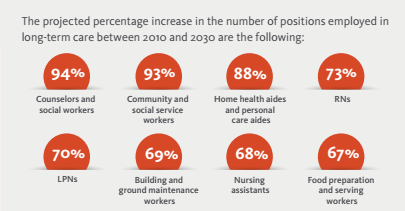
The first two segments of this series have focused on the growing need for senior care workers that will extend into 2030 and beyond. Now is the time for senior care leaders to begin planning and implementing strategies that will help them win the war for talent that has already begun and promises to persist in their industry.
People are the key. Winning the war starts with selecting the right talent and continues with strategies for retaining top performers. Providing opportunities for learning and development is one of those retention strategies, and this segment takes a deeper dive into talent development, particularly development of future leaders.
Investing in people’s growth helps your organization prepare for future needs. It also enhances your ability to retain, and even to recruit, highly talented people. As the population ages and more Baby Boomers retire, the need for workers in long-term care increases – it will nearly double between 2010 and 2030.
Millennials and the generation that follows them (Generation Z, born 2002 and after) will make up a significant portion of the workers who fill that gap. Opportunity for growth and development is the number one factor influencing both the attractiveness of an organization to Millennials and their willingness to accept a job offer according to a PricewaterhouseCoopers study.
Talent development should be a priority for your organization for three reasons then:
- It helps you attract and hire top talent.
- It helps you retain top performers.
- It helps you prepare your organization for the challenges of the future.
And those challenges for long-term care will be significant. A LeadingAge study projects a severe shortage in workers who specialize in geriatrics by 2030, when the need for such specialties will spike.

source: http://www.leadingage.org/sites/default/files/WorkforceFactSheet_0.pdf

source: http://www.leadingage.org/sites/default/files/WorkforceFactSheet_0.pdf
In this low-supply, high-demand environment, how can senior care leaders and managers prepare for the future by growing their own?
- Always be talking growth. Show your best team members these statistics.
- Ask people what they want to learn and how they want to grow. Create individualized development plans that suit each person.
- Paint a vision for the future that includes them as the solution to the shortages that will exist in the next decade.
- Support employees in finding and funding formal training or certification programs for geriatric specialties that are offered outside your organization.
- Internally, create learning and development programs featuring mentors and coaches from within your organization who can share their knowledge and experience to help others excel in this specialized area of care. (By the way, these internal development programs also represent a growth opportunity for those more experienced employees within your organization who serve as coaches and mentors).
How can leaders spot talent and potential for management or leadership among their frontline workers?
Looking for emerging leaders within your organization makes good business sense. When organizations promote from within they can expect a 70-80% success rate. When they make external leadership hires that success rate drops to only 50-55% – not much better than a coin flip (source).
Don’t make the mistake of believing that your top performers in a frontline role are your best candidates for jobs that involve managing people. Remember, the best players aren’t always the best coaches. Look for management and leadership potential. You can ask questions like these to get started, but a scientifically validated selection instrument is an even better indicator of leadership potential:
- Who asks great questions that push us beyond the status quo?
- Who is always learning more and connecting new ideas to our overarching goals?
- Who has the influence (even without formal authority) to advance ideas for making things work better?
- Who has a knack for seeing what other people do well and positioning those people to succeed in the process of achieving bigger picture team goals?
- Who do people naturally turn to for answers or advice or a listening ear?
- Who do you implicitly trust?
- Who elevates the game and the intensity of every other player when he or she enters the room?
- Who manages change and conflict in ways that keep people focused on achievement?
Putting it all together
The need for senior care will increase dramatically over the next decade. That growth has already started and it’s happening in an environment in which workers are going out the back door faster than they’re coming in the front door.
In these challenging times, some senior care organizations will thrive while others will struggle to survive. The difference between success and failure is likely to hinge on talent management. Those organizations who can retain and develop existing workers while attracting highly talented new workers will be the ones that thrive.
The secret sauce may vary from organization to organization, but those three elements of talent management – selecting the right people, retaining top performers and developing future leaders – are the key ingredients. These talent management strategies will help ensure that senior care organizations succeed in their mission to provide our elders with the high-quality, compassionate care they deserve.
This post is third in a three-part series that started with Select the Right People followed by Retain Top Performers.
Latest Posts: Blog

Blog November 04, 2025
Top Performers, Explained: Karl Giuseffi’s Blueprint to Thrive
Explore insights from Karl Giuseffi on how talent science enhances workplace success and team performance.
Read More
Blog October 22, 2025
Practical Ways to Give Feedback That Strengthens Talent and Growth
Learn how to give good feedback that inspires and builds trust among your team while enhancing their natural strengths.
Read More
Blog September 25, 2025
What Do We Really Mean When We Talk About Talent?
Unlock the secrets of talent in the workforce. Learn how to identify inherent abilities for excellence in your team.
Read More
Blog July 08, 2025
How to Manage Difficult People
Master how to manage difficult people at work with six effective strategies for maintaining productivity and engagement.
Read More
Selection April 28, 2025
The Science of Talent Reduces Turnover in Credit Unions
Learn how Credit Unions use Talent Plus Solutions to decrease turnover, better engage employees and increase performance.
Read More
Blog April 25, 2025
Building a Better Healthcare Team: Nebraska Spine Hospital’s Data-Driven Talent Approach
Find out how Nebraska Spine Hospital partners with Talent Plus to enhance employee engagement and organizational culture.
Read More
